British shadow factories
British shadow factories were the outcome of the Shadow Scheme, a plan devised in 1935 and developed by the British Government in the buildup to World War II to try to meet the urgent need for more aircraft using technology transfer from the motor industry to implement additional manufacturing capacity.
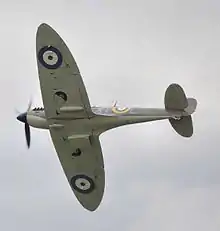
The term 'shadow' was not intended to mean secrecy, but rather the protected environment they would receive by being staffed by all levels of skilled motor industry people alongside (in the shadow of) their own similar motor industry operations.
A directorate of Aeronautical Production was formed in March 1936 with responsibility for the manufacture of airframes as well as engines, associated equipment and armaments. The project was headed by Herbert Austin and developed by the Air Ministry under the internal project name of the Shadow Scheme. Sir Kingsley Wood took responsibility for the scheme in May 1938, on his appointment as Secretary of State for Air in place of Lord Swinton.
Many more factories were built as part of the dispersal scheme designed to reduce the risk of a total collapse of production if what would otherwise be a major facility were bombed. These were not shadow factories, though some now use that name believing shadow refers to attempts to achieve a level of secrecy.
Purpose and use
It was impossible for these facilities to be secret, though they were camouflaged after hostilities began. They were war material production facilities built in "the shadow" of motor industry plants to facilitate technology transfer to aircraft construction and run, for a substantial management fee, in parallel under direct control of the motor industry business along with distributed facilities.[1] General Erhard Milch, chief administrator of the Luftwaffe, was in Britain again in the autumn of 1937 inspecting new shadow factories in Birmingham and Coventry, RAF aeroplanes and airfields.[2][3]:93
Background
Up until the middle of 1938, the Air Ministry had been headed by Lord Swinton. He had been forced by Prime Minister Neville Chamberlain to resign his position due to a lack of progress in re-arming the Royal Air Force, the result of obstruction by aging Lord Nuffield. Swinton's civil servants approached their new boss, Sir Kingsley Wood, and showed him a series of informal questions that they had asked since 1935 on the subject, such as those posed to Morris Motors with regard to aircraft engine production capability at their Cowley plant in Oxford.[4] As it turned out, the specialised high-output engines required by the RAF were made by Armstrong Siddeley, Bristol Aeroplane, Napier and Rolls-Royce, all of which employed a high number of sub-contractors. Despite their new factories, protestations by Wolseley Aero Engines (Nuffield) and Alvis were ignored. Their products were not required. Engines were specified by the aircraft's designers.[5] Nuffield did participate after Wood's appointment, providing the Castle Bromwich factory and promising a thousand Spitfires by June 1940 but, after two years, management was so poor that when June 1940 arrived not one Spitfire had been produced there. Castle Bromwich was withdrawn from Nuffield by Beaverbrook and placed under the wing of Vickers.[6]
Implementation
The plan had two parts:
- Development of nine new factories. The government would build and equip the factories. Motor car companies would be asked to gain experience in the making of engine parts so, if war broke out, the new factories could immediately go into full production.[7]
- Extensions to existing factory complexes to allow either easier switching to aircraft industry capability, or production capacity expansion.
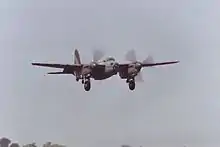
Under the plan, there was government funding for the building of these new production facilities, in the form of grants and loans. Key to the plan were the products and plans of Rolls-Royce, whose Merlin engine powered many of the key aircraft being developed by the Air Ministry, as well as Bristol's Hercules engine. Bristol Aeroplane would not allow shadow factories to build complete engines, only components.[3]:45 The exception was Austin.
The first motor manufacturers chosen for engine shadows were: Austin, Daimler, Humber (Rootes Securities), Singer, Standard, Rover and Wolseley.[5][3]:65 In the event Lord Nuffield took Wolseley out of the arrangement and Singer proved to be in serious financial difficulty.[7]
The buildings
Wood handed the overall project implementation to the Directorate of Air Ministry Factories, appointing Herbert Austin to lead the initiative (most of the facilities to be developed were alongside existing motor vehicle factories), and the technical liaison with the aircraft industry to Charles Bruce-Gardner. He also handed the delivery of the key new factory in Castle Bromwich, that was contracted to deliver 1,000 new Supermarine Spitfires to the RAF by the end of 1940, to Lord Nuffield, though in May 1940 the responsibility had to be taken from Nuffield and given to Vickers.[8]
The buildings were sheds up to 2,000 feet (610 m) long lit either by glazed roofs or "north-lit". Office accommodation was brick, and wherever possible faced a main road. These buildings were extremely adaptable and would remain part of the British industrial landscape for more than 50 years. One of the largest was Austin's Cofton Hackett, beside their Longbridge plant, started in August 1936. 1,530 feet (470 m) long and 410 feet (120 m) wide, the structure covered 20 acres (81,000 m2). Later a 15 acres (61,000 m2) airframe factory was added, then a flight shed 500 feet (150 m) by 190 feet (58 m) was attached to the airframe factory.[3]:66
.jpg.webp)
Rootes Blythe Bridge and Speke
The new factory buildings were models of efficient factory layout. They had wide clear gangways and good lighting, and they were free of shafting and belt drives.[3]:97 The five shadow factories in Coventry were all in production by the end of October 1937 and they were all making parts of the Bristol Mercury engine.[9] By January 1938 two of those shadow factories were producing complete airframes.[10] In July 1938 the first bomber completely built in a shadow factory (Austin's) was flown in front of Sir Kingsley Wood, Secretary of State for Air.[11] It was said eight shadow factories constructing aircraft components were in production in or near Coventry in February 1940.[12]
As the scheme progressed, and after the death of Austin in 1941, the Directorate of Air Ministry Factories, under the auspices of the Ministry of Aircraft Production (MAP), gradually took charge of the construction of the buildings required for aircraft production. In early 1943 the functions of the directorate of Air Ministry Factories were transferred to the Ministry of Works.
- Scotland
There were three waves of construction of shadow factories and only the third and smallest reached Scotland in the shape of the factory at Hillington producing Rolls-Royce's Merlin engines.[13] Ferranti's factory in Edinburgh will have been secret.
- Empire
Similar plans were introduced in Canada, Australia, New Zealand and South Africa.[14]
List of shadow factories (incomplete)
| Location | Manager for Ministry of Aircraft Production | Original use | Wartime production | Today |
|---|---|---|---|---|
| Acocks Green, south of Birmingham | Rover Aero | Westwood family's market garden | Parts for Bristol Hercules radial engine[3]:66 | Redeveloped as housing |
| Banner Lane, Coventry | Standard Aero No. 2 | Golf course | Bristol Hercules sleeve valve radial engines[3]:66[15] | Ferguson then Massey Ferguson tractors. Closed 2002. Now housing |
| Blythe Bridge, Staffordshire | Rootes Securities | Blenheim, Beaufort, Beaufighter[16] | Indesit cookers | |
| near Bolton, Lancashire | de Havilland | Airscrews | ||
| Browns Lane, Coventry | Daimler | Farmland | Aero engines,[17] Aircraft sub-assemblies[3]:66 | Jaguar's[18] Browns Lane plant, demolished 2008, now housing and an industrial estate |
| Burtonwood, Warrington | Fairey Aviation | Assembled and modified imported American aircraft | ||
| Canley-Fletchamstead Hy, Coventry | Standard Aero No. 1 | Vacant land on Standard's Canley site | Bristol Beaufighter De Havilland Mosquito[15] | Standard Motor Company demolished after closure in 1980. Now housing |
| Canley-Fletchamstead Hy, Coventry | H M Hobson | Vacant land on Standard's Canley site | Carburettors for aircraft engines[15] | Standard Motor Company demolished after closure in 1980. Now housing |
| Castle Bromwich, West Midlands | Nuffield Organisation then Vickers | Farm/Sewage works | 11,989 Supermarine Spitfires, Avro Lancaster | Dunlop Research Centre,[19] Fisher and Ludlow — Pressed Steel, Jaguar |
| Caversham (Star Road), Berkshire | Unknown | Purpose built factory | Spitfire fuselages and engines | Housing[20] |
| Christchurch, Hampshire | Airspeed | Airspeed Oxford[21] | ||
| Clifton near Manchester | Magnesium Elektron | Magnesium alloys[22] | ||
| Cofton Hackett, East Works, Longbridge | Austin | Farmland in Groveley Lane | Aero engines, Bristol Mercury and Pegasus[23] Aircraft production – Fairey Battle, Stirling, Avro Lancaster, Wellington Bombers[3]:66 |
Redeveloped as housing |
| Coventry, Stoke Aldermoor Lane | Humber | Aero engines[24] | ||
| Crewe, Cheshire | Rolls-Royce | Farmland | Rolls-Royce Merlin | Bentley Crewe |
| Cwmbran, South Wales | Lucas | Farmland | Aircraft turrets[3]:105 | |
| Distington, Cumbria | High Duty Alloys Ltd | Farmland | Aircraft parts made of Hiduminium | Abandoned[25] |
| Errwood Park, Stockport | Fairey Aviation | Beaufighters then Handley Page Halifax bombers | ||
| Drakelow Tunnels, Kidderminster | Rover Company | Hills | Parts for Bristol Mercury, Pegasus and Rolls-Royce Meteor engines[26] | Preserved as former Cold War site |
| Hillington, Glasgow | Rolls-Royce | Farmland | Rolls-Royce Merlin | Closed 2005,[27] redeveloped as an industrial estate. |
| Leyland, Lancashire, BX Factory | Leyland Motors | Greenfield site | Armoured Vehicle production 1940-1945 | Commercial vehicle production post war, site now re-developed |
| Meir, Stoke-on-Trent | Rootes Securities | Air Field | Harvard assembly, Mustang modifications | Aerodrome, now housing |
| Reading, Berkshire | Vincents | Coachworks | Spitfire parts | Thames Tower office block[28] |
| Reading, Berkshire | Great Western Motors | Garage | Spitfire parts | Retail park[29] |
| Ryton, south east of Coventry | Humber | Farmland | Aircraft engines[3]:66 | Car production, now redeveloped |
| Lode Lane, Solihull | Rover | Farmland | Parts for Bristol Hercules radial engine[30] | Land Rover Solihull manufacturing |
| Speke Airport, Lancashire | Rootes Securities | Speke Airport | Bristol Blenheim, Handley Page Halifax heavy bomber aircraft[31] | Dunlop tyres, footwear, golf and tennis balls,[32] now redeveloped as industrial estate |
| Staverton, Gloucestershire | Rotol | Staverton Airport | Variable pitch airscrews[33] | Rotol Gloucester Airport |
| Trafford Park, Manchester | Ford | Derelict motor assembly plant | Rolls-Royce Merlin | Modern industrial uses |
| Willesden, North London | Freestone and Webb | Coach builders | Wing tips for the Spitfire | Housing |
| Woodstock Mill, Oldham, Lancashire | H M Hobson | Cotton mill | Carburettors for aircraft engines | Distribution centre |
.jpg.webp)
Cofton Hackett and Castle Bromwich
Strategic dispersal
The White Paper on Defence published in February 1937 revealed that steps had been taken to reduce the risk of air attack delivering a knockout blow on sources of essential supplies, even at the cost of some duplication, by building new satellite plants which would also draw labour from congested as well as distressed areas.[34] There were still areas of severe unemployment.
London Aircraft Production Group
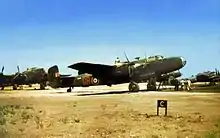
In parallel with the Shadow Factory scheme, the London Aircraft Production Group[35][36] (LAPG) was formed in 1940 by combining management of factories and workshops of
- Chrysler at Kew,
- Duple,
- Express Motor & Bodyworks Limited,
- Park Royal Coachworks and
- London Transport.
The major activity of the group was the production of Handley Page Halifax bombers for the RAF, ammunition, gun parts, armoured vehicles and spare parts for vehicles. The group was led by London Transport from their works at Chiswick, Aldenham Works and the new De Havilland factory at Leavesden, Hertfordshire, which had a large purpose-built factory and airfield (construction of both was authorised on 10 January 1940) for production, assembly and flight testing of completed Halifax bombers.[35]
The following list of eight members of the London Aircraft Production Group was published in March 1945:[37] This includes LAPG members with factories at Preston, Speke and Stockport.
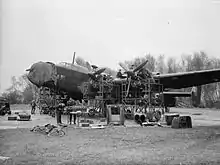
- English Electric in Preston
- London Passenger Transport Board — made the centre section and installed fittings and equipment for the front part of the fuselage
- Rootes Securities in Speke
- Chrysler Motors — rear part of the fuselage
- Express Motor and Body Works — intermediate wings and tail-plane
- Duple Bodies and Motors — the shell and components for the front part of the fuselage
- Park Royal Coachworks — outer wings
- Fairey Aviation Company in Stockport[37]
from May 1941 they took responsibility for final erection followed by the test flight and their first aircraft was airborne before the end of 1941. They were allotted their own aerodromes instead of sending aircraft to the Handley Page aerodrome.[38]
At peak the group involved 41 factories and dispersal units, 660 subcontractors and more than 51,000 employees,[39]
Ultimately output rose to 200 Halifaxes a month and the group provided something like 40 per cent of the nation's heavy bomber output. Halifax bombers dropped more than 200,000 tons of bombs.[37]
Sir Frederick Handley Page's "thank you" to these "daughter" firms was a luncheon at The Dorchester at which the head of each firm received a silver model of a Halifax bomber and representative workmen received scrolls of commendation.[37]
Due to the high priority placed on aircraft production, large numbers of workers were drafted with little experience or training in aircraft production, with over half the workforce eventually being female. At its peak the LAPG included 41 factories or sites, 600 sub-contractors and 51,000 employees, producing one aircraft an hour. The first Halifax from the LAPG was delivered in 1941 and the last, named London Pride, in April 1945.[35]
Follow-on initiatives
The shadow factory proposals and implementation, particularly its rigidity when bombed, meant that other key areas of military production prepared their own dispersal factory plans:
- Alvis had 20 sites in Coventry alone, producing vehicles and munitions.[40] Soon after the total destruction of the Alvis factory by enemy action in 1940 Alvis were operating eight dispersal factories and thus managed to resume deliveries of their most important products. They were allocated nine further dispersal factories following further enemy attacks and after Pearl Harbour at the end of 1941 Alvis organised, equipped and managed a new shadow factory to make variable pitch propellor hubs.[41]
- Rover managed and controlled six shadow factories on behalf of the Government and ran eighteen different dispersal factories of their own.[42]
- The Birmingham Small Arms Company Limited alone during the war controlled 67 factories from Small Heath.
List of dispersal factories (incomplete)
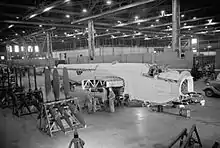
Extent
In June 1939 the response to a question in parliament was: 31 shadow factories were complete or under construction. The Air Ministry was responsible for 16 and, of those 16, 11 were working to full capacity.[54] By that time large numbers of Bristol engines and aircraft were being made in Government owned shadow factories and in the Dominions and other foreign countries.[16]
In February 1944 Parliament was advised there were 175 managing agency schemes or shadow factories.[55]
National Archives catalogue entries
Information concerning the shadow factory plan and shadow factories can be found among the following records and descriptive series list code headings held by The National Archives. For the full set of references (including German shadow factories) see the Catalogue below:
| Catalogue reference | description |
|---|---|
| AIR 19/1-10 | Shadow scheme and factories, 1935–1940 |
| AIR 20/2395 AIR 20/2396 | Shadow factories schemes |
| AIR 2, code 6/2 | Aircraft production, shadow factories |
| AVIA 15, code 25/1 | Factories general |
| AVIA 15, code 25/5 | Shadow factories |
| T 161/1070 | Insurance of Government property managed or maintained by private contractors; `Shadow' factories |
| T 161/1156 | Banking: Shadow factories banking accounts |
References
- S E Little and M S Grieco of Oxford University quoted in Robson, Graham (2011). The Book of the Standard Motor Company. Veloce. ISBN 978-1-845843-43-4.
- "General Milch On R.A.F. Progress". The Times (47824). 25 October 1937. p. 21.
- Nutland, Martyn (2012). Brick by Brick: The Biography of the Man Who Really Made the Mini – Leonard Lord. Authorhouse. ISBN 978-1-4772-0317-0.
- "Shadow Scheme: Morris Motors Ltd". National Archives. Retrieved 20 November 2010.
- "White Paper Aero-Engines". The Times (47518). 29 October 1936. p. 7.
- David Owen. Dogfight: The Supermarine Spitfire and The Messerschmitt BF 109. ISBN 9781473828063 Barnsley, South Yorkshire : Pen & Sword Aviation, 2015
- "Two Schemes Confused". The Times (47515). 26 October 1936. p. 11.
- McKinstry, Leo (14 November 2007). "How labour unrest nearly lost us the Battle of Britain". The Spectator.
- "Equipment For The R.A.F.". The Times (47825). 26 October 1937. p. 16.
- "Completing Shadow Factories". The Times (47893). 15 January 1938. p. 7.
- "News in Brief". The Times (48054). 23 July 1938. p. 9.
- "Great Britain In War-Time". The Times (48534). 8 February 1940. p. 5.
- "Industrial Scotland". The Times (49710). 23 November 1943. p. 5.
- "Defence Forces and Policy. Cooperation with Britain". The Times (47902). 26 January 1938. p. 54.
- Robson, Graham (2011). The Book of the Standard Motor Company. Veloce. ISBN 978-1-845843-43-4.
- "Bristol Aeroplane Company". The Times (48363). 21 July 1939. p. 21.
- "The Birmingham Small Arms Company Limited". The Times (48457). 9 November 1939. p. 14.
- "Jaguar Cars Ltd". The Times (51986). 27 April 1951. p. 10.
- "Dunlop Research Centre". The Times (51712). 9 June 1950. p. 2.
- http://www.bcar.org.uk/supermarine-spitfire
- "Airspeed Limited". The Times (50351). 16 January 1946. p. 8.
- "Building R.A.F. Machines". The Times (48068). 9 August 1938. p. 9.
- "Austin Motor Company". The Times (50413). 29 March 1946. p. 10.
- "Aero-Engines At Coventry". The Times (47492). 29 September 1936. p. 16.
- "High Duty Alloys Ltd", Distington". Cumbria Archive Service Catalogue. Archived from the original on 27 October 2016.
- Stokes, Paul (1996). Drakelow Unearthed. BCS/Paul Stokes. pp. 11–12. ISBN 0-904015-40-8.
- Sherrard, Peter (2011). Rolls-Royce Hillington: Portrait of a Shadow Factory. Rolls-Royce Heritage Trust. pp. 108–110. ISBN 978-1-872922-45-4. Historical Series Nº 44.
- http://news.bbc.co.uk/local/berkshire/hi/people_and_places/history/newsid_8913000/8913056.stm
- https://forums.autosport.com/topic/97565-johnnie-wakefield/
- Bobbitt, Malcolm (2002). Rover P4 Series. Veloce. p. 19. ISBN 9781903706572.
- "Faster Bombers". The Times (48142). 3 November 1938. p. 11.
- "Dunlop Rubber". The Times (50165). 11 June 1945. p. 10.
- "Rearmament Surveyed". The Times (47933). 3 March 1938. p. 9.
- "White Paper On Defence". The Times (47611). 17 February 1937. p. 8.
- "London Aircraft Production (L.A.P.)". Exploring 20th Century London. Archived from the original on 10 September 2018.
- Lang, David. "Halifax Bomber Production at Park Royal Coachworks". Brindale Engineering.
- "Group Production Of Halifaxes". The Times (50097). 1 March 1945. p. 2.
- "R.A.F. Bombers Built By L.P.T.B.". The Times (50010). 7 December 1944. p. 2.
- Nancy, Peter G. (2014). British Aircraft Manufacturers since 1909. Fonthill Media. ISBN 9781781552292.
- Stratton, Michael; Trinder, Barrie Stuart (2000). Twentieth Century Industrial Archaeology. E & FN Spon. p. 74. ISBN 9780419246800. Retrieved 8 April 2015.
- "Alvis Limited". The Times (50340). 3 January 1946. p. 7.
- "The Rover Company". The Times (50341). 4 January 1946. p. 8.
- "Company Meeting". he Times (48673). 20 July 1940. p. 9.
- Nye, James (2014). A Long Time in the Making. Oxford University Press. ISBN 978-0-19-871725-6.
- "How 30,000 Jobs Were Created by Sebastian Z. de Ferranti". The Times (57567). 23 May 1969. p. III.
- Historic England. "MoD Corsham: Personnel Lift (PL) 2 (1409130)". National Heritage List for England.
- "Fafnir Factory Opening". The Times (55344). 20 March 1962. p. 19.
- Young, Peter (1983). Power of Speech - A History of Standard Telephones and Cables. London: George Allen & Unwin. pp. |page= 92. ISBN 0 04 382039 5.
- A. C. Cossor Limited. The Times, 24 October 1940; pg. 9; Issue 48755
- "Top secret World War II past of Newtown's Lion Works". BBC News. 13 June 2011.
- "General Electric Company". The Times (48672). 19 July 1940. p. 9.
- "Industry has only to...". The Times (58743). 28 March 1973. p. 30.
- "Mr. C. H. Tucker". The Times (53320). 8 September 1955. p. 14.
- "House Of Commons". The Times (48338). 22 June 1939. p. 8.
- "Capital Assistance for Industry, House Of Commons". The Times (49776). 10 February 1944. p. 8.
External links
- Building Beauforts in Australia
- The Shadow Scheme a 1-hour 10 minute documentary released 15 July 2013
- "Production – what is wrong?", Flight, 14 April 1938 – A contemporary critic of the pre-war expansion of UK aircraft production